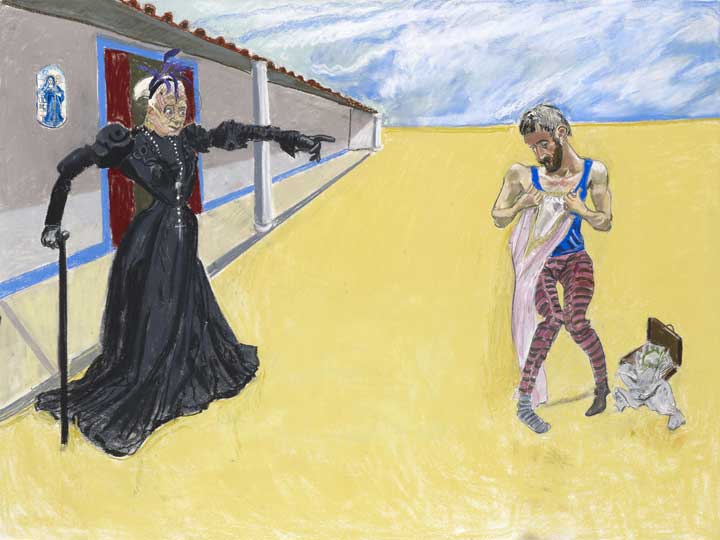Manuel II, the last king of Portugal, certainly earned his sobriquet ‘ O Desventurado’ (‘the unfortunate’): after his father and older brother were shot dead by members of the Portuguese Republican Party in 1908 he ascended to the throne for a tumultuous two years that ended in a republic for Portugal and a life in exile for Manuel. He was 18 when he became king; photos show a chubby smiling adolescent more prepared for a life of leisure than leadership. He relied heavily on his mother, Queen Amélia, which didn’t help matters, and seven governments collapsed before the Republicans finally claimed the country in October 1910. Manuel escaped to Gibraltar, and then England, where he lived until his somewhat suspicious death in 1932 (he may have been poisoned).
Paul Rego is another Portuguese exile and bibliófilo (‘I can’t work in Portugal, but I do things about Portugal here.’) Her latest exhibition, at Marlborough Fine Art, is a triple bill: pastels inspired by Manuel II, a series based on The Relic, the 1887 novel by José Maria Eça de Queirós which tells the story of the devious Teodorico Raposo and his visit to the Holy Land, and a set of watercolours for a new version of the folk story Stone Soup by her daughter, Caroline Willing (published by Enitharmon Press).
The pictures are a surprise. Rego’s familiar tropes are still evident – strong women, emasculated men, structures of power and humiliation, fairy tales and animals – but the style is less stylised, more playful and daring. In Rowing from Ericeira, which shows the young king and his mother escaping Portugal, Manuel rows an inflatable dinghy wearing a checked shirt (he was a populist), cradling his mother in her furs. The cliffs behind are roughly coloured; the unfinished shape of a donkey is outlined on the beach.
In Magpie the infantilised king suckles on his mother’s lap; he in his shiny shoes, she with her little legs outstretched stiffly like a doll (a Rego family story has Queen Amélia’s breasts popping out of her dress while travelling over cobbles in an open-topped coach). In a shadowy reversal behind, a female artist (Artemisia? Rego?) is embraced by the massive ghostly figure of a male painter (Goya?) who colours in the magpies. One for sorrow, two for…? It’s not quite clear. In The King’s Death Rego’s talent for depicting fabric is put to good use in brocade and sheets and voluminous dresses. The king sprawls in the centre in throat-constricted agony while a nurse looks on; but in the mirror at the side the king appears further back and the nurse looks off into the future.
But the real pleasure of the show is The Relic series. Somewhere between Flaubert, Candide and The Master and Margarita, Eça de Queirós’s novel satirises religion and greed in equal measure. Teodorico, a young libertine desperate to inherit the fortune of his pious aunt, goes to the Holy Land in search of a relic to restore her health and prove his devotion. In Jerusalem he dreams of meeting the devil – who complains that pagan religions were ‘sweet and beautiful’ compared with Christianity – and attends the crucifixion. Rego draws Teodorico’s aunt as an imperious monster, banishing him to the desert (he quivers, knees-knocking, in stripy leggings, clutching a dress). He prostates himself to the shrine at a mad dinner party, over which hangs a sinister pietà– the subject of the next picture, where the red-faced sack-like body of the Christ figure is stabbed with swords and knives.
The images are rough and sexy and messy and vulgar, the decadence of suffering and debauchery meet in the blood red and magenta, pious purple, yellows and sickly greens. In Dream Teodorico sleeps on a beach cradling what looks suspiciously like a bust of Freud, while behind him the devil leers out from a rock, distracting partygoers from the crucifixion illuminated in the giant sun above. The Holy Land is dominated by the splayed, bleeding body of a donkey in front of the Dome of the Rock; a present wrapped in red ribbon sits in the foreground like a bomb. A tawdry angel wears a pink mini-dress; maybe she’s on a hen night. It would make a good Christmas card.
Rego doesn’t go all the way to the journey’s end: Teodorico returns to Portugal with a crown of thorns he fashions from a bush, and makes a career importing all sorts of Middle Eastern tat – nails, wood, sandal, scraps of tunic, sand – to sell as relics to the incredulous villagers. He doesn’t make much headway with aunt though: she leaves everything to her (very impious) priest.
‘Paula Rego: The Last King of Portugal and Other Stories’ is at Marlborough Fine Art until 25 October.
Related Articles
